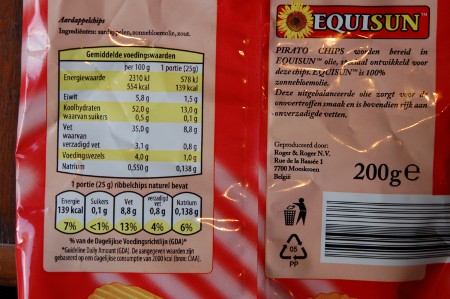Food labelling has always been a contentious issue here in the Netherlands. To be quite honest I’m not current on all the arguments or discussions, but I do know new labels have appeared on our food here in the last several months. In the past I’ve heard things off and on about how food manufactures didn’t want a ‘stop light’ system of labelling, because they didn’t want any food clearly labelled as ‘unhealthy’. Supposedly food manufacturers were to be absolutely forbidden from making even indirect health claims about their products. Apparently as well as in the Netherlands there have been disputes between different countries as well.
I also don’t see labelling on all foods, so I’m not sure where it’s mandatory or not. Anyone reading this in other European countries see the same labelling where you are? Does anyone know if we have a standard system yet or not?
As far as I can tell when I look at our new food labels is the food manufactures must have totally won the fight.
The reality of course is these labels are not so much about providing consumer information as they are to teach us to eat more processed foods. Food companies in North America have for decades been making huge profits by teaching people about the different ingredients in food; salt, fat, sugar, oils, protein, etc. By teaching us some are better and some are unhealthy, they make consumers go crazy buying foods without some things, and with extra other things added. Even if there are no explicit health claims on the packages, there are public information campaigns teaching us what and what not to eat.
I’m starting to see that more and more in mass media here, for example on the BBC. I have ad blocking software on my browser, so display ads don’t appear, but increasingly the BBC is running ‘infomercials’, about some new study somewhere that says we should eat more or less of some ingredient that’s commonly found in processed foods, or about how we are supposed to drink more or less alcohol.
On the subject of alcohol consumption there was some controversy recently because the government apparently was citing a study which gave safe alcohol on a weekly basis, but taking the numbers, dividing them by 7, and calling them a safe daily consumption. This was obviously flawed math on the part of the government.
They are very much trying to start the same advertising campaigns and processed food promotions here that led to the obesity problems of North America.
For the record Steph and I are vegetarian, emphasize fresh and local foods over processed ones, buy most of our food from neighborhood organic markets and cook nearly all of our own meals. In particular, we make it a point of sitting down and eating at least one meal together every day.
When you eat meals like this it’s very easy to make a mockery of nearly all dietary advice. For example, the latest advice making the rounds here is no one should eat more than 6g or about 1 tsp of salt every day. There’s no way Steph and I come anywhere near that on any kind of regular basis. Even adding up all the salt we put on our food at the table, the salt in our bread and cheese and the salt we cook with. We occasionally buy other processed foods besides bread and cheese, and even taking into account what these contain, we are still no where close. It’s possible on the odd day we go over a little bit, but I do not consider this any risk to our health.
There is simply no reason for Steph and I to count the salt in all of our foods, or cut down or anything else, unless we want to give ourselves an eating disorder. While there may be some reason to believe eating too much salt is unhealthy, although I can’t confirm this, there is no credible evidence to suggest if you are not eating too much salt that eating less is any healthier for you. In particular there’s no evidence the low salt crazes America has gone through over the years have improved anyone’s health.
There’s a similar argument to be made for calories, protein, fat, oils and everything else that’s supposed to be either good or bad for you. If you eat a varied diet, that doesn’t have too much meat or processed foods, the chances are you meet every credible nutritional guideline ever published without trying.
What are we talking about here?
The picture above is from a bag of ribbled potato chips (crisps). It’s a 200g bag, or a little less than a half pound, in my opinion what a typical consumer would eat over a day or two. A teenager could probably polish it off in an hour. In any case, it’s packaged in the size consumers buy and will mostly be eaten by 1 or 2 people within a short period of time, so it’s not really sensible to talk about the food value of anything but the entire bag and any talk of ‘servings’ is pretty much nonsense.
There are many people who would like to get into an argument over how unhealthy it is to eat a bag of chips like this. It’s an unbelievably emotional subject for many people. I mean, just look at it — it’s a bag of potato chips! Right? What junk! Calories! Fat! Who can justify eating something like that? People on government benefits shouldn’t be allowed to buy food like this — right? To all people like this, all I can say is get over it.
It’s too bad it isn’t easier to buy a higher quality product at a comparable price, in particular potato farmers use a lot of chemicals and potatoes themselves contain a lot of residues. This and the fact they are made in bulk without any sort of quality standards. Otherwise the ingredients from the label above are: Potatoes, Sunflower Oil and Salt. It’s still a processed food, and there are always problems with processed foods, but it’s a lot better than many alternatives. For many centuries before WWII and the Irish Potato Famine, many people lived primarily on these sorts of food ingredients. While I wouldn’t suggest anyone should live only on potato chips, you could do a lot worse.
One of the issues with standard potato chips like these is they are one of the cheapest food alternatives, and the food manufactures want you to buy more expensive foods, and want everyone to think there is something somehow wrong with a food that’s so cheap.
What’s on the Label?
I’m not going to translate every word on the label, but going to Google then selecting Language Tools you can find a translator.
On the bottom is what everyone is suppose to pay the most attention to, from left to right:
Calories: 139 — 7%
Sugars: 0.1g — <1%
Fat: 8.8g — 13%
Saturated Fat: 0.8g — 4%
Sodium: 0.138g — 6%
These are all for a 25g serving, and since the bag is 200g, you have to multiply all these numbers by 8. For your convenience:
Calories: 1112 — 56%
Sugars: 0.8g
Fat: 70.4g — 104%
Saturated Fat: 6.4g — 32%
Sodium: 1.104g — 48%
The percentage figures are GDA or ‘Guideline Daily Amount’. Whatever this means. Maximum or minimum? The package doesn’t say.
So what have we learned here? Is it that when we eat an entire bag of potato chips every day, this alone will put our fat intake 4% over the limit? What happens if we eat two bags a week, can we average out these numbers? Of course we are all focused on that 104% figure, just what exactly are the health consequences of going 4% over the limit?
The fact of the matter is there is no useful information here. It’s not possible to draw any conclusions about how healthy this product is for you, except emotional conclusions.
These figures are solely so consumers have a way of choosing processed foods they eat, and so they think some are healthier than others, without the manufactures making any explicit health claims.








